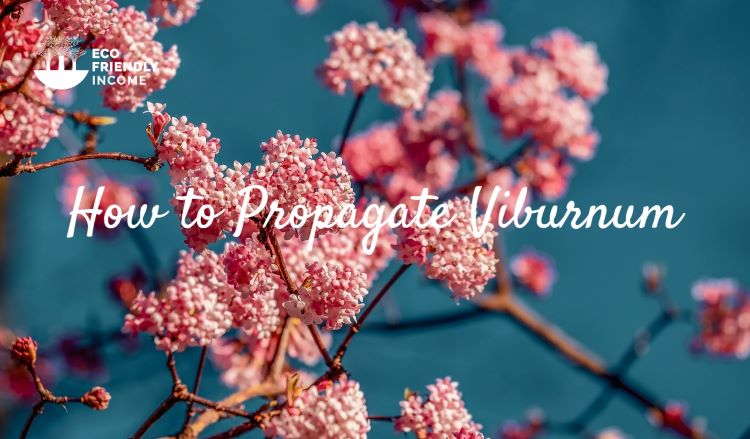A field guide on how to identify and propagate Downy Arrowwood (Viburnum rafinesquianum), a hardy shrub that is native to eastern North America.
How to Identify Downy Arrowwood (Viburnum rafinesquianum)
Leaves

Downy arrowwood leaves are ovate to elliptical shape, with dentate margins, and grow on the stems in opposite arrangements.
The lower leaf surface of downy arrowwood is covered in fine hairs.
Fruit

The berries are dark-blue to black, and have a spherical to egg shape. They grow on long, branched stems.
Flower

The flowers are small, white, and unpleasantly fragrant. They are clustered together in flat-topped or slightly rounded inflorescences and each flower has five oval-shaped petals arranged in a radial pattern around a central stamen.
Flowering Season
Downy arrowwood flowers typically bloom from late spring to early summer.
Fruits then follow, but aren’t mature until late summer.
Habitat
You can find downy arrowwood (Viburnum rafinesquianum) typically growing in wooded areas, along stream banks, and on rocky slopes.
Some other understory plants that associate with downy arrowwood are:
- Common Snowberry – Symphoricarpos albus
- Bunchberry (Cornus canadensis)
- Bluebead (Clintonia borealis)
Wildlife Value
Downy arrowwood is a fruiting plant, which means it will always provide some benefits to wildlife.
Small mammals like chipmunks and squirrels will sometimes eat the fruits
Gamebirds and songbirds also eat their fruits and use their foliage for protection.
Large mammals such as deer and moose will occasionally browse the shrub.
How to Propagate Downy Arrowwood (Viburnum rafinesquianum)

Hardiness Zone: 2-8

Soil Type: Well-drained, moist loam, sand.

Water: Normal.

Exposure: Full Sun to Partial Shade
You can propagate downy arrowwood with two effective methods:
- Stem Cuttings: It provides established trees faster, but is tricky.
- By Seed: Viburnum seeds require long stratification and sowing time, but can still be effective on large scale.
How to Propagate Downy Arrowwood (Viburnum rafinesquianum) by Seed
If you can identify wild downy arrowwood, then you can harvest their seeds easily. It’s all a game of patience.
For viburnum, the longer you wait to harvest the fruits, the better.
That’s because the seeds require a long warm stratification period. The longer you wait to harvest, the least you have to worry about the warm stratification.
The perfect time to harvest downy arrowwood fruits for the seeds is late summer to early fall.

How to Harvest Seeds
Hand-pick the seeds or use a hand rake to make the berries fall into a container. When home, put the berries into a blender with some later and blend at low speed.
Next, remove the floating pulp, and drain the juice with a sieve to get the seeds.
Stratification
Downy arrowwood stratification period is 60 days warm, and 90 days cold.
Sowing
Sow the seeds in the spring under at least 1/4″ soil, compact lightly, and mulch the seed bed.
Seeds are slow to germinate.
How to Propagate Downy Arrowwood (Viburnum rafinesquianum) by Cuttings
If you want to propagate downy arrowwood fast, the best method is from cuttings. As for viburnum, the optimal timing is at the semi-hardwood stage.
It’s this year’s growth, but when it’s starting to harden.
Harvesting Season: Wait at least 6 weeks after the first leaves of spring.

- Cutting length: Aim for 4-5 inches for each cutting, with 2 pairs of nodes.
- Rooting Soil: Coarse sand is the best rooting medium you can use to propagate downy arrowwood.
- Duration: Let the cuttings root throughout the whole summer without tampering with them.
- Wintering: Bring them in to overwinter or leave them under the cover of snow.
- Transplant Time: Re-pot the cuttings in a good compost/soil mix when they awaken the following spring.
For the final touch, add some slow-release fertilizing granules. Feel free to place the cuttings in a sunny location. Water regularly.
Downy arrowwood is a species of viburnum, and they all propagate in a similar way.
If you want to get a more detailed breakdown of how to propagate viburnum, take a look at our parent article:

FAQ
A: Downy Arrowwood is a small Viburnum plant that typically grows to a height of 5-8 feet. It has a rounded, bushy shape and multiple upright stems.

